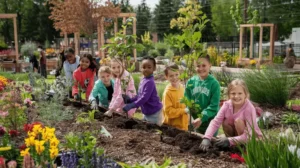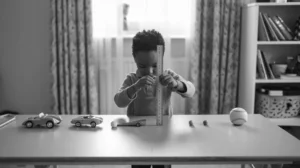Home / Good Manners
Manners Matter: The Importance of Teaching Good Manners to Kids for Positive Social Development

Good manners refer to a set of social behaviors and actions that are considered polite, respectful, and appropriate in various situations. Good manners are important because they help to create a positive social environment, build strong relationships, and show respect for others.
Some examples of good manners include saying “please” and “thank you,” holding the door open for someone, using appropriate language and tone, being punctual, and showing respect for other people’s opinions and beliefs. Good manners also involve showing consideration for others, such as not interrupting when someone is speaking or offering to help when someone needs it.
Overall, good manners are an important aspect of social interaction and can have a positive impact on both personal and professional relationships. By practicing good manners, we can show respect for others and create a more positive and respectful social environment.
Good Manners Definition
Good manners can be defined as polite, respectful, and appropriate behavior that shows consideration for others. It involves using socially acceptable language, showing proper etiquette in different situations, and treating others with respect and kindness. Good manners can include basic things like saying “please” and “thank you,” holding the door open for someone, and showing respect for other people’s opinions and beliefs.
It can also involve more complex behaviors like being punctual, using proper table manners, and knowing how to conduct oneself in a professional setting. Overall, good manners help to create a positive and respectful social environment and build strong relationships with others.
Importance of Good Manners for Kids
Teaching good manners to kids is important for several reasons:
Building social skills: Good manners help kids to develop positive social skills and interact respectfully with others, which can lead to strong and healthy relationships.
Showing respect: Learning good manners teaches kids to show respect and consideration for others, regardless of their background or beliefs.
Developing self-confidence: Kids who have good manners feel more confident in social situations and are more likely to succeed in academic and professional settings.
Creating a positive environment: When everyone practices good manners, it creates a positive and respectful social environment that benefits everyone.
Improving communication: Good manners help kids to communicate effectively and respectfully with others, which is an important skill in all areas of life.
Encouraging empathy: Teaching good manners helps kids to develop empathy and kindness towards others, which can lead to a more compassionate and understanding society.
Overall, good manners are essential for kids to develop into well-rounded, respectful, and successful adults. By teaching kids good manners, we can help them to build strong relationships, succeed in life, and contribute positively to their communities.
Good Manners for Kids - Example
Teaching good manners to kids is an important aspect of their social development. Here are some good manners that kids can learn:
Saying “please” and “thank you” when asking for or receiving something.
Greeting people with a smile and a hello.
Using proper table manners, such as chewing with their mouth closed, using utensils properly, and waiting for everyone to be served before starting to eat.
Saying excuse me when they need to get someone’s attention or move past someone.
Holding the door open for others.
Using polite language, such as “excuse me,” “may I,” and “thank you.”
Respecting others’ personal space and belongings.
Using an indoor voice and not interrupting others when they are speaking.
Showing empathy and kindness towards others, such as offering to help when someone is in need.
Apologizing when they make a mistake or hurt someone’s feelings.
By teaching kids these good manners, we can help them to develop positive social skills and build respectful relationships with others.
Explained 10 Good Manners for Kids
1. Saying "please" and "thank you" when asking for or receiving something
Saying “please” and “thank you” when asking for or receiving something is a common courtesy that shows respect and consideration for others. It is a way of acknowledging that someone else is doing something for us and expressing gratitude for their actions. Using polite language is an important social skill that helps to build positive relationships and creates a sense of mutual respect and appreciation. By using “please” and “thank you,” we show that we value the efforts and contributions of others and recognize their importance in our lives. Additionally, using polite language can help to diffuse potentially tense or confrontational situations, and create a more positive and collaborative environment for everyone involved.
2. Saying "please" and "thank you" when asking for or receiving something
Greeting people with a smile and a hello is a simple act of kindness that can have a big impact on others. It is a way of acknowledging someone’s presence and showing that you value them as a person. A smile and a friendly hello can help to create a positive and welcoming environment, and can help to build positive social connections.
When kids learn to greet others with a smile and a hello, they are developing an important social skill that can help them to navigate a variety of social situations. Whether they are meeting someone new, interacting with peers, or communicating with adults, a friendly greeting can help to establish a positive tone and set the stage for a successful interaction.
Additionally, greeting people with a smile and a hello can help to boost kids’ confidence and self-esteem. When they receive positive feedback and acknowledgement from others, they are more likely to feel valued and appreciated, and this can help to build their sense of self-worth.
Overall, greeting people with a smile and a hello is a simple yet powerful way to show respect, kindness, and consideration for others. By cultivating this habit in kids, we can help to create a more positive and harmonious social environment for everyone.
3. Using Proper Table Manners
Using proper table manners is an important aspect of good manners for kids. It involves a set of behaviors and practices that show respect for others, as well as an understanding of basic social norms and expectations. Some examples of proper table manners include:
Chewing with your mouth closed: This helps to avoid making noise or showing food in your mouth, which can be unpleasant for others.
Using utensils properly: Forks and knives should be used to cut and eat food, while spoons can be used for soup or other liquid dishes.
Waiting for everyone to be served before starting to eat: This shows consideration for others and helps to ensure that everyone has a chance to enjoy their meal together.
Using napkins: Napkins should be used to wipe your mouth and hands, and should be placed on your lap when not in use.
Sitting up straight and not slouching: This shows respect for the meal and for others at the table.
By practicing proper table manners, kids can learn to show respect for others and develop a greater sense of social awareness. They can also learn to appreciate the value of shared experiences, such as family meals or communal dining, and develop a greater appreciation for food and the social bonds it can create.
4. Saying Excuse Me
Saying “excuse me” is an important aspect of good manners for kids. It is a way of showing consideration for others and acknowledging their presence and space. Some examples of when kids should say “excuse me” include:
When they need to get someone’s attention: Saying “excuse me” can be a polite way to get someone’s attention without interrupting them.
When they need to pass by someone: Saying “excuse me” can help to avoid bumping into someone or invading their personal space.
When they accidentally do something wrong: Saying “excuse me” can be a way of apologizing for a mistake and showing that they recognize their error.
By saying “excuse me,” kids can learn to show respect for others and develop a greater sense of social awareness. They can also learn to communicate more effectively and navigate social situations with greater ease.
5. Holding the Door Open for Others
Holding the door open for others is an act of kindness and consideration that is an important part of good manners for kids. It involves taking a moment to be aware of others around you and being willing to help them out in a small but meaningful way. Some examples of when kids should hold the door open for others include:
When someone is carrying something heavy: Holding the door open can make it easier for them to pass through without dropping their load.
When someone is pushing a stroller or wheelchair: Holding the door open can make it easier for them to pass through without having to navigate the door themselves.
When someone is walking behind you: Holding the door open can show that you are aware of their presence and willing to help them out.
By holding the door open for others, kids can learn to show empathy and consideration for others, as well as develop a greater sense of awareness of their surroundings. They can also learn to look for opportunities to help others out in small but meaningful ways, and to create a more positive and supportive social environment for everyone.
6. Using Polite Language
Using polite language is an important aspect of good manners for kids. It involves using words and phrases that show respect for others and demonstrate an understanding of basic social norms and expectations. Some examples of polite language include:
“Excuse me”: This is a polite way of getting someone’s attention or asking them to move aside.
“May I…”: This is a polite way of asking for permission to do something, such as borrow a toy or use the bathroom.
“Thank you”: This is a way of expressing gratitude and showing appreciation for something that has been done for you.
“Please”: This is a way of making a request politely and acknowledging that the other person has the right to say no.
By using polite language, kids can learn to communicate effectively and respectfully, as well as develop a greater sense of empathy and consideration for others. They can also learn to navigate social situations more effectively and create a more positive and supportive social environment for everyone.
7. Respecting Others' Personal Space and Belongings
Respecting others’ personal space and belongings is an important aspect of good manners for kids. It involves being aware of others’ physical boundaries and showing consideration for their possessions. Some examples of respecting others’ personal space and belongings include:
Not touching or taking things that belong to others without permission: This shows respect for their property and the value that they place on their belongings.
Keeping a respectful distance from others when talking or interacting with them: This shows that you are aware of their personal space and are willing to give them the room that they need.
Asking before hugging, touching, or playing with others: This shows that you respect their boundaries and are willing to ask for permission before engaging in any physical contact.
By respecting others’ personal space and belongings, kids can learn to show consideration for others and develop a greater sense of empathy and social awareness. They can also learn to communicate more effectively and navigate social situations with greater ease, creating a more positive and supportive social environment for everyone.
8. Using an Indoor Voice and Not Interrupting others
Using an indoor voice and not interrupting others is an important aspect of good manners for kids. It involves being aware of your surroundings and showing consideration for others’ needs and preferences. Some examples of using an indoor voice and not interrupting others include:
Speaking in a quiet and respectful tone when indoors: This shows that you are aware of others’ needs and preferences, and are willing to adjust your behavior to create a more comfortable and respectful environment.
Waiting for others to finish speaking before speaking yourself: This shows that you are respectful of others’ thoughts and opinions, and are willing to listen and engage in a respectful and constructive dialogue.
Asking for permission before interrupting others: This shows that you respect others’ time and attention, and are willing to wait your turn to speak.
By using an indoor voice and not interrupting others, kids can learn to communicate more effectively and respectfully, as well as develop a greater sense of empathy and consideration for others. They can also learn to navigate social situations more effectively and create a more positive and supportive social environment for everyone.
9. Showing Empathy and Kindness towards Others
Showing empathy and kindness towards others is an essential aspect of good manners for kids. It involves understanding and responding to the feelings and needs of others, and treating them with kindness, respect, and compassion. Some examples of showing empathy and kindness towards others include:
Offering help when someone is in need: This shows that you are willing to lend a hand and support others in times of need.
Listening attentively and showing understanding when someone is upset: This shows that you care about their feelings and are willing to provide a listening ear and emotional support.
Being inclusive and welcoming to others: This shows that you value diversity and are willing to create a positive and supportive environment for everyone.
Being kind and respectful in your interactions with others: This shows that you treat others with dignity and respect, and are willing to engage in positive and constructive interactions.
By showing empathy and kindness towards others, kids can develop stronger social skills and emotional intelligence, as well as a greater sense of connection and community. They can also build stronger relationships and create a more positive and supportive social environment for everyone.
10. Apologizing when They make a Mistake
Apologizing when they make a mistake is an important aspect of good manners for kids. It involves taking responsibility for one’s actions and showing remorse when they have hurt someone else. Some examples of apologizing when they make a mistake include:
Saying “I’m sorry” when they have done something wrong: This shows that they are willing to take responsibility for their actions and make amends for any harm caused.
Offering to make things right: This shows that they are willing to take action to repair any damage caused by their actions and restore trust and goodwill.
Learning from their mistakes and making an effort to avoid repeating them: This shows that they are committed to personal growth and development, and are willing to take constructive feedback and make positive changes.
By apologizing when they make a mistake, kids can learn to take responsibility for their actions, build stronger relationships, and create a more positive and supportive social environment for everyone. They can also develop greater self-awareness and emotional intelligence, which can serve them well in all aspects of their lives.
How to Inculcate Good Manners
Here are some tips on how to have good manners:
Be polite: Say “please” and “thank you” when you make a request or receive something.
Use proper etiquette: Follow the proper etiquette in different situations, such as using the correct utensils at the dinner table or introducing yourself to someone new.
Show respect: Treat others with respect and kindness, regardless of their background or beliefs.
Practice good communication: Use appropriate language and tone when speaking to others, and listen actively when others are speaking.
Be punctual: Arrive on time for appointments and events.
Show consideration: Be considerate of others’ feelings, needs, and personal space.
Control your emotions: Avoid showing anger or frustration in public, and handle conflicts calmly and respectfully.
Dress appropriately: Dress appropriately for different occasions, and avoid wearing revealing or offensive clothing.
Be helpful: Offer to help others when you see that they are struggling or in need.
Take responsibility: Take responsibility for your actions and apologize when you make a mistake.
By practicing these behaviors, you can improve your manners and show respect and consideration for others in your social interactions.
Good Manners Quotes
Here are some famous quotes about good manners:
“Manners are a sensitive awareness of the feelings of others. If you have that awareness, you have good manners, no matter what fork you use.” – Emily Post
“Good manners and kindness are always in fashion.” – Unknown
“The hardest job kids face today is learning good manners without seeing any.” – Fred Astaire
“Good manners cost nothing, but earn everything.” – Unknown
“Politeness is the flower of humanity.” – Joseph Joubert
“Manners are a way of showing other people we care about them.” – Marylin Manson
“Good manners will open doors that the best education cannot.” – Clarence Thomas
“Manners are a way of getting what you want without appearing to be an absolute swine.” – Unknown
“Manners are the lubricating oil of an organization. It is a law of nature that two moving bodies in contact with each other create friction.” – Peter Drucker
“Manners are a social lubricant – without them, society grinds to a halt.” – Unknown
These quotes emphasize the importance of good manners in our daily interactions with others, and how they can help us to show respect, kindness, and consideration towards others.
Good Manners for Kids - FAQs
Good manners for kids include behaviors such as saying “please” and “thank you,” using proper table manners, greeting others politely, showing empathy and kindness towards others, and respecting personal space and belongings. Good manners are important because they help children develop positive relationships with others, show respect and consideration for others, and set the foundation for good social skills and successful interactions in both personal and professional settings.
Parents can teach good manners to their children by modeling the behaviors they want to see, consistently reinforcing good manners when they are exhibited, providing clear expectations and rules, and using positive reinforcement such as praise and rewards. Role-playing scenarios can also be an effective way to teach children how to use good manners in various situations.
Examples of good manners for kids include saying “please” and “thank you,” using proper table manners, greeting others with a smile and a hello, showing empathy and kindness towards others, respecting personal space and belongings, using polite language, apologizing when they make a mistake, and holding the door open for others.
To reinforce good manners in a child, parents should consistently model and reinforce the desired behaviors, provide clear expectations and rules, use positive reinforcement such as praise and rewards, and redirect or correct negative behaviors using gentle guidance and feedback.
To correct a child’s bad manners without being too harsh, parents should use gentle guidance and feedback, focus on correcting the behavior rather than criticizing the child, and provide positive reinforcement when the desired behavior is exhibited. It’s important to avoid shaming or blaming the child and instead focus on teaching and reinforcing positive behaviors.
To teach a child to respect others’ personal space and belongings, parents can model the behavior they want to see, provide clear rules and expectations, use role-playing scenarios to practice respectful behavior, and provide positive reinforcement when respectful behavior is exhibited. It’s important to emphasize the importance of respecting others and their belongings and to provide clear consequences for violating this rule.
If a child is rude or disrespectful to others, parents should address the behavior immediately by using gentle guidance and feedback, redirecting the behavior, and providing clear consequences for the negative behavior. It’s important to emphasize the importance of treating others with respect and kindness and to model the desired behavior.
To encourage a child to apologize when they make a mistake, parents can model the behavior by apologizing when they make a mistake, use role-playing scenarios to practice apologizing, provide clear expectations and rules for apologizing, and use positive reinforcement such as praise and rewards when the child apologizes.
Good manners can help children develop positive relationships with peers and adults, communicate effectively, show respect and consideration for others, and build social and emotional intelligence. These skills can be invaluable in both personal and professional settings and can lead to greater success and happiness in life.
Yes, there are cultural differences in good manners that parents should be aware of when teaching their child. It’s important to research and understand the cultural norms of different communities and to teach children to be respectful and considerate of these differences. Parents can also model open-mindedness and respect for different cultural traditions and customs.







